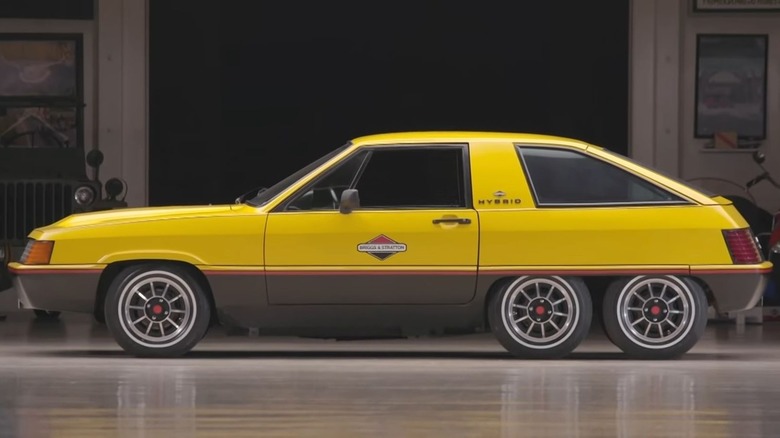The Six Wheeled Hybrid Car You'd Never Guess Was Built By A Lawnmower Company
Briggs & Stratton says it is the "world's largest small engine producer," making internal combustion engines for lawnmowers, snow blowers, and generators. So when they popped out a fully formed, six-wheeled, bright yellow hatchback car loaded down with twelve batteries in 1980, people were shocked.
However, this one-off concept wasn't the engine maker's attempt at entering the car manufacturing arena. Instead, it was intended to show that automobiles could be made with much smaller engines than the mainstream public (and Detroit) realized. And, of course, generate some buzz around the company.
In 1973, the OPEC oil crisis that hit the United States caused a paradigm shift in the automobile industry. Car makers had to move away from making colossal gas guzzlers to smaller, more fuel-efficient vehicles. Then, in 1974, President Nixon signed the Emergency Highway Energy Conservation Act, which mandated a national maximum speed limit of 55 miles per hour.
To move away from using fossil fuels and simultaneously show the American public that cars didn't need big engines to go the new speed limit, Briggs & Stratton came up with its parallel drive Hybrid. It could scoot around using a conventional gas-powered internal combustion engine and switch to a battery-powered motor on the fly.
Briggs & Stratton tabbed Brooks Stevens to design the car. You may not know the name, but you probably know some of the cars he created, including the iconic Oscar Mayer Wienermobile, the Willys-Overland Jeepster, and several concept cars like the Cadillac Die Valkyrie, the Studebaker Sceptre, and the amphibious Evinrude Rooney Lakester.
The lawnmower car had the chops to cut it in Motor City
Stevens worked on the "lawnmower car" with his son Kipp (via Road & Track), designing the front end and rear hatchback from the ground up. However, they took the doors, dash, and windshield from a second-gen Volkswagen Scirocco, and the 4-speed manual transmission, clutch, front suspension, and rack-and-pinion steering from a Ford Pinto (via Jay Leno's Garage).
Under the hood was a "stock" Briggs & Stratton 42-ci (694-cc) engine kicking out a mere 18 horsepower at 3,600 rpm. The horizontally-opposed 2-cylinder engine was air-cooled, and had a seven-gallon gas tank (via Hagerty). Company Engineering Technician Craig Claerbout claimed the car got 30 mpg at 55 mph, a 200-300% improvement over most other vehicles at the time (via Jay Leno's Garage), proving that a small engine could indeed work as intended.
In back, sitting above the dually wheels, were twelve Globe-Union 6-volt DC lead acid batteries that supposedly had a range between 40 and 60 miles (via Jay Leno's Garage). All those batteries required a second axel and a set of wheels that acted like a trailer to support the weight. Despite that, the car only weighed 3,200 pounds (via Road & Track).
The car hit a top speed of 68 mph ... on a closed track driven by none other than the King of NASCAR, Richard Petty. While Leno was behind the wheel, he got it up to 60 mph, but the car hadn't been driven since 1988. If the world had been a little more open-minded in 1980, we might all be driving around "lawnmower cars" today.
